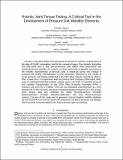Robotic Joint Torque Testing: A Critical Tool in the Development of Pressure Suit Mobility Elements
Author(s)
Meyen, Forrest Edward; Holschuh, Bradley T.; Kobrick, Ryan L.; Jacobs, Shane; Newman, Dava
DownloadNewman_Robitic joint.pdf (801.3Kb)
OPEN_ACCESS_POLICY
Open Access Policy
Creative Commons Attribution-Noncommercial-Share Alike
Terms of use
Metadata
Show full item recordAbstract
Pressure suits allow pilots and astronauts to survive in extreme environments at the edge of Earth’s atmosphere and in the vacuum of space. One obstacle that pilots and astronauts face is that gas-pressurized suits stiffen when pressurized and greatly limit user mobility. As a result, a critical need exists to quantify and improve the mobility characteristics of pressure suits. A historical survey and critique of pressure-suit testing methodologies is first presented, followed by the results of recent pressure suit testing conducted at the MIT Man-Vehicle Laboratory (MVL). MVL researchers, in cooperation with the David Clark Company (Worcester, MA), used an anthropometrically-realistic robotic space suit tester to quantify pressure suit mobility characteristics of the S1034 Pilot Protective Assembly (PPA), a pressure suit worn by U-2 pilots. This suit was evaluated unpressurized, at a vent pressure of 5.5 kPa (0.8 psi), and at an emergency gauge pressure of 20.7 kPa (3 psi). Joint torque data was collected for elbow flexion/extension, shoulder flexion/extension, shoulder abduction/adduction, and knee flexion/extension motions. The aim of this study was to generate a robust baseline mobility database for the S1034 PPA to serve as a point of comparison for future pressure suit designs, and to provide recommendations for future pressure garment testing.
Date issued
2011-07Department
Massachusetts Institute of Technology. Department of Aeronautics and Astronautics; Massachusetts Institute of Technology. Engineering Systems DivisionJournal
41st International Conference on Environmental Systems
Citation
Meyen, Forrest, Bradley Holschuh, Ryan Kobrick, Shane Jacobs, and Dava Newman. “Robotic Joint Torque Testing: A Critical Tool in the Development of Pressure Suit Mobility Elements.” In 41st International Conference on Environmental Systems. 17 - 21 July 2011, Portland, Oregon, American Institute of Aeronautics and Astronautics, 2011.
Version: Author's final manuscript
ISBN
978-1-60086-948-8
1618393324